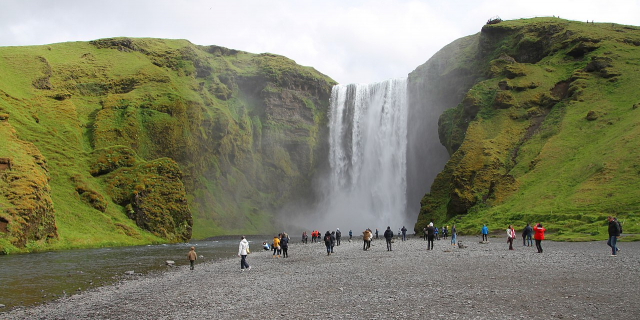Heimaey
Heimaey (Icelandic pronunciation: [ˈheiːmaˌeiː] ), is an Icelandic island. At 13.4 square kilometres (5.2 sq mi), it is the largest island in the Vestmannaeyjar archipelago, and the largest and most populated island off the Icelandic coast. Heimaey is 4 nautical miles (7.4 km; 4.6 mi) off the south coast of Iceland. It is the only populated island of the Vestmannaeyjar islands, with a population of 4,414. The Vestmannaeyjar Airport and the Westman Islands Golf Club taken together cover a good portion of the island.
In January 1973, lava flow from nearby Eldfell destroyed half the town and threatened to close its harbour, its main income source. An operation to cool the advancing lava with sea water saved the harbour.
Abducted from the north of Ireland, the slaves were called westmen (Vestmenn), as before discovering Iceland, Ireland was the most western part of the world known to northern Europeans then (c. 840). The slaves went ashore at Heimaey and took shelter in the hills. Ingólfur hunted them and killed them in revenge for their murdering his foster brother. In the process, he named various places and landmarks. For example, he named "Dufþekja", an area on Heimaklettur, Heimaey's highest hill, after the slave Dufþakur (the Icelandic version of the Gaelic 'Dubhthach,' Anglicized as 'Duffy') who was said to have thrown himself off Heimaklettur at that point, preferring to take his own life than to let Ingólfur take it.
First settlersIn tradition, Herjólfur Bárðarson was said to be the first person to settle in Heimaey. According to the Landnáma, he built his farm in Herjólfsdalur (literally: Herjólf's valley) about 900. The archaeological excavation in 1971 of ancient ruins in Herjólfsdalur revealed that there had been settlement nearly 100 years earlier.[1]
Turkish raidIn 1627, three Arab pirate ships from the Ottoman-controlled Barbary Coast raided several towns on the south coast of Iceland and outlying islands.[2] They attacked Grindavík and Heimaey. In Grindavík, townspeople could flee into the lava field of Reykjanes and hide indefinitely. Heimaey was so isolated that it was vulnerable and people suffered. Many heroic stories were told of the people who survived the invasion, most notably Guðríður Símonardóttir. Better known as Tyrkja-Gudda (Turkish-Gudda), she was taken by the pirates from her home at Stakkagerði on Heimaey to the slave market in Algeria. She was eventually ransomed back to Denmark by King Christian IV of Denmark and was re-educated by and later married the poet Hallgrímur Pétursson. The Hallgrímskirkja Lutheran church in Reykjavík is named in his honour.




























Add new comment